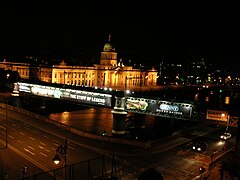
Back Loopline Bridge German Loopline zubia Basque Droichead na Lúblíne Irish Loopline Bridge Italian
Loopline Bridge Droichead na Lúblíne | |
|---|---|
 Loopline bridge at night (prior to removal of advertising hoardings), with Butt Bridge in the foreground, and Custom House in the background | |
| Coordinates | 53°20′53″N 6°15′17″W / 53.3480°N 6.2546°W |
| Carries | Railway |
| Crosses | River Liffey and quays |
| Locale | Dublin, Ireland |
| Other name(s) | Liffey Viaduct |
| Maintained by | Iarnród Éireann |
| Preceded by | Butt Bridge |
| Followed by | Talbot Memorial Bridge |
| Characteristics | |
| Material | Cast iron, wrought iron, limestone (viaduct piers) |
| History | |
| Designer | John Chaloner Smith |
| Construction end | 1891 |
| Location | |
 | |
The Loopline Bridge (or the Liffey Viaduct, Irish: Droichead na Lúblíne[1]) is a railway bridge spanning the River Liffey and several streets in Dublin, Ireland. It joins rail services from south of Dublin to Connolly Station and lines north.
Designed by John Chaloner Smith (engineer to the Dublin, Wicklow and Wexford Railway), the bridge was built between 1889 and 1891.[2] It consists of wrought iron lattice girders on a double row of piers with five spans. The viaduct is approximately six metres above street level and supports two railway tracks.[3]
During original planning and construction (in the late 19th century) the project was subject to much opposition and controversy,[4] because the structure blocks the view down river to The Custom House. However, the bridge was deemed necessary as a rail link between north and south Dublin, and to facilitate the movement of transatlantic mail coming from Kingstown (Dún Laoghaire) and Queenstown (Cobh).[3]
100 years later, the visage of the bridge remains the subject of some debate,[5] and has been described by historian Richard Killeen as "one of the city's true eyesores".[6] Already arguably less attractive[7] than some of Dublin's other bridges, the façades of the Loopline have been used by Iarnród Éireann for billboard advertising. As of 2006[update], the company has scaled back the bridge's use for this purpose[8] to reduce impact on the city skyline, following input from An Bord Pleanála and Dublin City Council.[9]
A prominent feature in the city landscape since 1891, the Loopline Bridge appears in one of the most famous literary works associated with Dublin:
A skiff, a crumpled throwaway, Elijah is coming, rode lightly down the Liffey, under Loopline bridge, shooting the rapids where water chafed around the bridgepiers, sailing eastward past hulls and anchorchains, between the Customhouse old dock and George’s quay.


- ^ "Loopline Bridge/Droichead na Lúblíne". logainm.ie.
- ^ "Loopline Bridge - Design and Engineering". Bridges of Dublin. Dublin City Council. Retrieved 9 October 2017.
- ^ a b "Project history of Dublin's River Liffey bridges" (PDF). 156 Issue BE4. Bridge Engineering - Phillips & Hamilton. December 2003. Archived from the original (PDF) on 12 August 2017. Retrieved 9 October 2017.
- ^ Liffey Bridges Survey Team (1987). The Liffey bridges from Islandbridge to Eastlink: a historical and technical report (Report). Dublin: Liberties Association.
- ^ "News - Hoardings to be cleared from the Loopline bridge". Irish-architecture.com. 21 November 2004. Archived from the original on 27 July 2012.
- ^ Killeen, Richard (2009). Historical Atlas of Dublin. Dublin: Gill and Macmillan. p. 135. ISBN 978-0717145959.
- ^ "Hoardings to be cleared from the Loopline bridge". Sunday Business Post. 21 November 2004. Archived from the original on 11 July 2012 – via Irish Railway News.
- ^ "Architectural forum discussion with pictures showing removal of Loopline hoardings". Archiseek.com. 29 November 2002. Archived from the original on 19 July 2012.
- ^ "Order and decision regarding advertising on Liffey Viaduct (Loop-line Bridge)". An Bord Pleanála. 18 March 2004. Retrieved 9 October 2017.